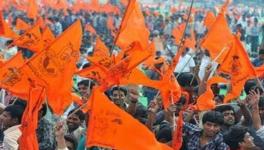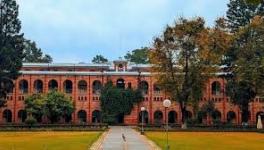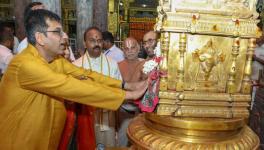Battle of Ideas: Ambedkar Brass Coin vs Statue of Unity
On 8 August, a cavalcade comprising buses and trucks is slated to begin its nearly 1,000-km yatra from the campus of the Dalit Shakti Kendra at Sanand, Ahmedabad. It will wend its way through north Gujarat, cross the border to enter Rajasthan, and then sweep into Delhi before reaching Parliament on the evening of 13 August, two days before India celebrates the 75th anniversary of its Independence.
The yatra’s schedule ostensibly suggests the yatris have been inspired by India’s spectacular journey since Independence. But then, as is said, the apparent is rarely ever the complete story. In fact, the yatris would be there to remind Parliament that even though Article 17 abolished untouchability, this social malaise continues to treat a segment of Indians as less than human.
As an indictment of Parliamentarians for their failure to abolish untouchability and as a reminder to them to make that as their objective over the next 25 years, the yatris will be ferrying on one of the trucks a one-tonne brass coin. One side of the coin will depict Dr BR Ambedkar, with the line: Will the 1947 Dream of Untouchability-Free India Be a Reality in 2047?
It is for this reason the massive brass coin’s diameter has been kept 2047 millimetres. The diameter symbolically expresses the hope that when India celebrates the 100th year of Independence, in 2047, untouchability would have disappeared from our public life.
The obverse side of the coin will have the image of Gautam Buddha, who founded Buddhism to establish the principle of equality, now enshrined in the Indian Constitution, as both a spiritual and temporal goal for humans to achieve.
Once the yatris reach Parliament, they will present, as is the plan, the one-tonne Ambedkar brass coin to the President, the Vice-President and the Speaker of the Lok Sabha. Letters requesting that they accept the coin will soon be despatched to them, with a plea that it be showcased in the new Parliament building, which is being built at a frenetic pace.
The yatris will also gift to Parliament three truckloads of Re 1-coin, totalling Rs. 26 lakh. These coins are people’s contribution to the fund for building the new Parliament, which, after all, belongs to all Indians, in whom the sovereignty rests. Among those who will join the yatris in the presentation ceremony would be representatives from at least seven political parties.
Two MPs—Rashtriya Janata Dal’s Manoj Jha and VCK (Viduthalai Chiruthaigal Katchi) leader Tholkappiyan Thirummavalavan—have consented to join the presentation ceremony. As to why he agreed, Jha explained, “The coin is a metaphor to make the government realise that its regressive journey, defined by the bulldozer and digging up of the past, will not help realise the constitutional dream of equality, which ought to be this great nation’s mission.”
Idea behind the coin
The yatra has been conceptualised by Martin Macwan, academician and founder of the Navsarjan Trust, which runs the Dalit Shakti Kendra, that seeks to enhance the consciousness of Dalits and skill them. Macwan had an epiphany when the Central Vista Project, of which the new Parliament building is centrepiece, was announced by the Modi government. Should not the people, particularly Dalits, remind the builders of the new Parliament that the promise of abolishing untouchability remains unfulfilled?
Yes, the voice in Macwan murmured. “How would you do it,” the voice asked.
He was, out of the blue, reminded of a mythical story he had read in primary school. In an indeterminate century, the followers of Buddha decided to cast his statue in gold. People made their offerings. The gold was melted and poured into a mould. But when the mould was opened, Buddha’s face had a crack. Stricken with disappointment and believing it was merely a technical glitch, they undertook the exercise all over again. But the crack on Buddha’s face, once again, reappeared.
The head priest gathered all the monks and asked them: Did anyone refuse an offering? Yes, said the youngest of them, he had turned down the donation of an old lady who had offered a copper coin, which he thought was useless for their project. A delegation of monks rushed to the lady and beseeched her to part with the copper coin, which was then mixed with the gold. When they cracked open the mould, the statue of Buddha had a smile.
This myth underscores the principle of equality in our social life.
Sacrifice of an Untouchable
The coin has also a cultural resonance in Gujarat, best articulated through a legend popular in the State. Siddhraj Jaysinh (1092-1142), of the Chaulukya (aka Solanki) dynasty, commissioned Od Rajputs, the lower-caste migrants from Rajasthan, to dig a water tank—Sahasralinga Talao—in Patan. Among the diggers was Jasma Odan, wife of Rudo. Her beauty captivated Jaysinh, considered the foremost of Gujarat’s kings. He made amorous advances on her, even promising to make her as his queen. Enraged by her rejection, Jaysinh killed Rudo and threatened to slaughter Ods.
Jasma, in grief, killed herself but not before cursing the king that the tank would remain dry and his kingdom would be conquered by a Muslim ruler-saint. Jaysinh, according to the folk tale, consulted the astrologer who claimed Jasma’s curse could be neutralised by sacrificing a perfect man, or one who possessed 32 virtuous attributes. A search led the royal party to Megh Maya, aka Mayo, who was persuaded to voluntarily agree to being sacrificed for the larger collective good.
An untouchable belonging to the Dhedh subcaste, Megh agreed, subject to certain conditions. The king must exempt his community members from wearing humiliating caste markers, such as sporting a turban before stepping out in the public arena, hanging a spittoon and a broom from around their necks, and dressing up in garments with three sleeves. The third sleeve was used for tying the broom.
A desperate Jaysinh agreed. Megh was sacrificed in the deep recess of the Sahasralinga Talao. As his blood flowed out, the tank filled with water.
The tale of Jasma has been incorporated in “Bhavai, a form of Gujarati theatre that evolved in the 14th century, as representing a culture of opposition to the dominant culture,” Prof Svati Joshi writes in her essay, “Mapping a History of Consciousness: Gujarati Folk Theatre”. The essay provides the English translation of a folk song that celebrates Jasma’s resistance to an unjust ruler. Here are some snatches of it:
Siddhraj: Jasma, take only a little soil/Your beautiful waist will bend.
Jasma: O mad king, don’t talk such foolishness/ Our waists are made of iron.
Siddhraj: Jasma, wear diamonds and silk garments/Don’t wear such tattered clothes.
Jasma: Give diamonds and silk garments to your queens/Tattered clothes are fine for us poor people.
When Jaysinh threatens to kill the entire Od community, in an attempt to overcome Jasma’s resistance, Jasma laments:
Don’t kill the poor, o king, /This is the poor community of Ods, / Don’t kill the poor. / I hate my beauty/ And curse my birth. /Don’t kill the poor.
Jasma, according to the song, then curses:
Shame on you, o sinning king, what have you done today? /Since you have killed poor Ods, a Pir will take your kingdom.
The tale of Jasma has been dismissed by historians.
The Great Spin
Joshi, however, writes, “The dismissal of the Jasma story by the established historians reveals their ideological bias which would not tolerate any account that would damage the glorious image of the greatest Hindu king that ever ruled Gujarat.” Mainstream historians regard the reign of the Solanki or Chaulukya kings, between the 10th and 13th centuries, as the golden period of Gujarat’s history, not least because they expanded their rule over the region that acquired its present name ‘Gurjardesa’ or Gujarat. “It acquired a distinct identity, known in Gujarati as ‘asmita’ [pride],” Joshi points out.
It was to protect Gujarat’s asmita that an attempt was made to reinterpret the story of Jasma. She was hailed for spurning the royal luxuries in order to do her duty to her husband. Joshi is biting in her comment, “This is a typical rewriting of the legend by the middle-class intelligentsia in the 19th century in which the powerful account of confrontation between low-caste labourers and a lustful tyrant is turned into a justification of sati or a faithful wife who kills herself on the death of her husband.”
This writer does not know the ideological orientation of the historians referred to by Joshi. Yet their view of the past is no different from Hindutva ideologues. They reject stories about the gross misconduct of Hindu rulers but enthusiastically cite medieval chroniclers who engaged in hyperbole to record the endeavour of Muslim rulers to spread Islam.
Joshi suggests: “… A triumphalist, homogeneous and unified ‘asmita’ was forged in Gujarat at the cost of diversity. Today when it is revived with increased vigour, it may be necessary to recognise this other, oppositional consciousness that too has thrived through centuries in Gujarat and to retrieve and revive it with full vigour… It may be useful to listen to this different voice which has been vibrant in Gujarat through centuries.”
Clash of Ideas
It is claimed that Dalits, in the bygone era, were sacrificed before the foundation for a royal building was laid. This could well be a case of caste oppression being re-imagined. Yet, in a two-part essay published in Gyanodaya, a Marathi fortnightly, in February and March 1855, 14-year-old Mukta Salve, hailed as the first Dalit female writer, wrote, “They would make the Mangs and Mahars drink oil mixed with red lead and bury our people in the foundations of their buildings, thus wiping out generation after generation of our poor people.” Among the first batch of girls who studied in a school established by Jyotirao Phule and Savitiribai Phule, Salve does not cite sources for her claim. Nor does she claim to have witnessed such barbarity.
In parts of Gujarat, though, even today, a coin and a brass lota are placed in the foundation of houses. The lota symbolises water and the coin prosperity, just as the sacrifice of Megh had water bubble up in Patan’s tank, which is a protected monument. The Megh memorial there was allocated Rs. 3 crore in 2018 by the State government.
Essentially then, by making the Ambedkar brass coin, Martin Macwan has linked a myth and legend to a contemporary cultural practice.
On 20 March, a call was given for people to donate utensils or items of brass, however small. When 2450 kg of brass utensils were collected from 15 States—although the bulk of it came from Gujarat—the Dalit Shakti Kendra asked people to stop sending their contributions other than Re 1 coin for each member of their families. Niruben Chorasiya, a Dalit activist in Bhavnagar, said to me, “Yes, we asked people to stop sending brass utensils. Mind you, Muslims and some OBC groups too have contributed to the project.”
Macwan’s original idea was to have the Ambedkar brass coin placed in the foundation of the new Parliament building. But his plan was aborted because the Covid-19 pandemic slowed the collection of brass, and Prime Minister Narendra Modi unexpectedly laid the foundation for the new Parliament on 10 December 2020.
Now, the yatris will request to place the Ambedkar brass coin in Parliament, hoping that every MP would work to realise the principle of equality. And every visitor would hear the lament of a people still reeling under untouchability.
There is an obvious parallel between Modi’s successful project of erecting the Statue of Unity, which depicts Sardar Patel, in Kevadiya, Narmada district, and the people’s plan of making or minting the Ambedkar coin. For the Statue of Unity, people contributed iron. For the Ambedkar coin, brass has been collected. The statue measures 182 meters in height; the Gujarat Assembly has 182 MLAs. The brass coin is 2,047 millimetres in diameter; the year 2047 is when untouchability is hoped to be rooted out from India.
Yet the two projects are also a study in contrast. The Statue of Unity was built through a public-private partnership with Gujarat, the Union government and public sector units contributing money for it. This became, in reality, a state-driven project, which also uprooted Adivasis from their land. The statue was built in the full glare of media publicity. Since the Kevadiya project celebrates Sardar Patel for integrating 562 princely states into India, the statue privileges the idea of territorial integrity.
The parallel between the Statue of Unity and the Ambedkar coin has not been lost to the contributors. Narendra Parmar, a Dalit activist in Patan, said to me, “The Patel samaj is wealthy and they contributed iron for building the Patel statue. We are doing the same for the Ambedkar coin, and have the nation focus on abolishing untouchability, which torments us alone. Yet some Muslims, Adivasis and OBCs have pitched in.” Niruben, of Bhavnagar, added, “Babasaheb is dear to us, as Patel is to the Patel samaj. We cannot let down Babasaheb.”
By contrast, the Ambedkar brass coin is a people’s initiative. The state has not contributed a penny to it. But, above all, the Ambedkar brass coin celebrates the notion of equality and tells the nation its future must be liberated from the past and the present, which is marked by untouchability, exclusion and discrimination. It will be a pity if the national media, obsessed with mandir-masjid disputes, fails to focus on the one-tonne Ambedkar brass coin and the Ahmedabad-Delhi yatra that creatively re-imagines the constitutional idea of India.
The author is an independent journalist. The views are personal.
Get the latest reports & analysis with people's perspective on Protests, movements & deep analytical videos, discussions of the current affairs in your Telegram app. Subscribe to NewsClick's Telegram channel & get Real-Time updates on stories, as they get published on our website.
























